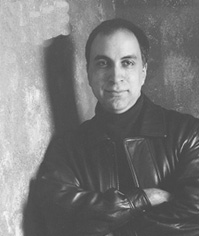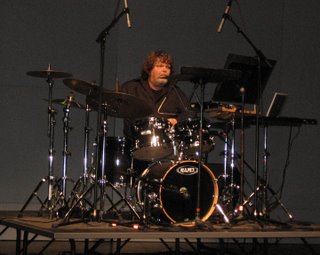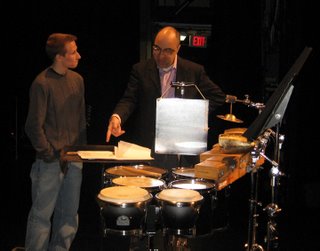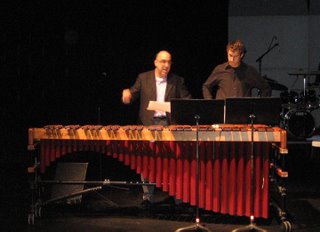
Composer Anthony Cornicello (born in Brooklyn, New York, 1964) writes music that blurs distinctions between performers and electronics, timbre and harmony, composition and improvisation, and explores the boundaries of what may be considered post-classical concert music. His music is vibrant and visceral, full of rhythmic energy and harmonic sophistication, and his forays into live electronics have led to exciting combinations of instruments and processed sound. Cornicello’s background as a jazz pianist is evident not only in the rhythmic activity of his music, but also in his constant investigation of the rich sonorities available from a variety of instruments.
He has been commissioned to write music for the Scorchio Electric String Quartet, ModernWorks! (funding from Meet the Composer/ Commissioning Music USA), the Auros Group for New Music, the Prism Saxophone Quartet, the New York New Music Ensemble, David Holzman, the Group for Contemporary Music, and the InterEnsemble of Padova, Italy. His work has also been featured on the Guggenheim Museum’s “Works and Process” series. Cornicello’s works have also been performed by the Chicago Civic Symphony, Parnassus, ALEA III, Composers Concordance, Madeleine Shapiro, Robert Black, among many other outstanding groups and solo performers. His music has been presented as part of the Darmstadt International Festival of New Music as well as the June in Buffalo Festival.
Cornicello’s Second String Quartet has been recorded by the Atlantic String Quartet; the Second Sonata for Piano by David Holzman (Centaur). More recently, his Post-Modern Waltz was recorded by Eric Moe for Albany Records. A portrait CD of Cornicello’s works is scheduled for 2006 release on Albany Records.
As a performer, he has conducted or played piano in his own works on numerous occasions. While a graduate student at Rutgers, he formed and directed the Janus Ensemble, a group dedicated to contemporary music. More recently, Cornicello has begun performing on the laptop, using a variety of interfaces and the Max/MSP program. Those performances, mostly with EEE!, have had a notable impact on his music, as EEE!’s music ranges from hip-hop to experimental noise. EEE! is based at Eastern Connecticut State University, where Cornicello is an Associate Professor and Director of the Electronic Music Lab.
Cornicello received the Ph.D. from Brandeis University, where he studied with David Rakowski, Eric Chasalow, and Martin Boykan. His teachers also include Charles Wuorinen, Gérard Grisey, and Richard Beirach.
His current fields of interest include developing unusual interfaces for live computer music performances, as well as continuing to investigate resonance and spatialization. His recent and current projects (mostly for string instruments and electronics) have been exploring the latter two, and the series of experimental works ReZenant Garden, performed by EEE! have operated on all three areas of interest. Future projects will include works for instrumental groups or soloists and electronics, as well as turntablists.
Cornicello's works are published by C.F. Peters Corporation and APNM, and he is a member of BMI.
|
|
|
|
|
|

Thursday, March 19, 2009
Composer-in-Residence at William Paterson
Earlier this month, I had the honor of being the 13th Composer-in-Residence (Hmm, good thing I'm not superstitious!) at William Paterson University. It's an honor to be amongst the composers who have been previously honored, like Babbitt, Crumb, Wuorinen, and Reich. Most importantly, it was a thrill being at William Paterson, where the enthusiasm of the students is downright electrifying.

Most of this energy emanates from Pete Jarvis, who is on the left, rehearsing my Janaka Blast. I've known Pete since my days at Rutgers in the 1980s, and it was nice to reconnect with him and the gang over at William Paterson. Pete commissioned me to write a piece for drums, to which I added an electronic part. You can barely see the laptop at the far right of the set-up, but it's there!
The title for Janaka Blast refers to a rhythm found in Indian music, a 7/8 groove that appears towards the end of my piece. Pete gave the first performance on March 5, 2009, while I was at William Paterson. He's going to play it a number of times this year, which is always a plus. I'm waiting to hear the tape of the premiere, but I'm happy to see that there are other performances upcoming. There are always little things to be changed.
Next up was undergraduate (!) Ant hony O'Connor, playing my piece Pluto/Charon. That piece is from the 1990s, when I was writing very difficult music. Apparently, Anthony has been working on this piece for several months, and it shows. I was quite amazed that someone took the time to play this work - it's for solo mixed percussion. Y ou can see the set-up that he has in the photo to the left. There are passages where he's got to connect the entire set of instruments in one phrase, and I've got to say he did a great job. The performance was incredibly smooth. And, I did get to say "when I was your age, Pluto was a planet!" hony O'Connor, playing my piece Pluto/Charon. That piece is from the 1990s, when I was writing very difficult music. Apparently, Anthony has been working on this piece for several months, and it shows. I was quite amazed that someone took the time to play this work - it's for solo mixed percussion. Y ou can see the set-up that he has in the photo to the left. There are passages where he's got to connect the entire set of instruments in one phrase, and I've got to say he did a great job. The performance was incredibly smooth. And, I did get to say "when I was your age, Pluto was a planet!"
There was an excellent performance of a more recent work for Marimba, Low Five. The "low" in the title refers to the low end of a 5 octave marimba - I think around 95% of the piece is all below middle-C. Payton MacDonald did an excellent job with this piece! There are passages that I refer to as "Michael Brecker" licks - fast, repeating scale/arpeggio lines that appear in the midst of a fast section. Payton nailed them! Here's a photo of us talking about the work. I don't know what I'm saying, but apparently it's true - Italians talk with their hands...

There was also a panel discussion - on my music! Shea Auditorium was pretty full at this point, and many students had some great questions. We even continued beyond the regular program, with a few students coming up to me afterwards.
This reminds me: I've got to get back to writing more works for percussion. For a while, I've been avoiding it, although not for any particular reason.
posted by Anthony Cornicello
|
| |



